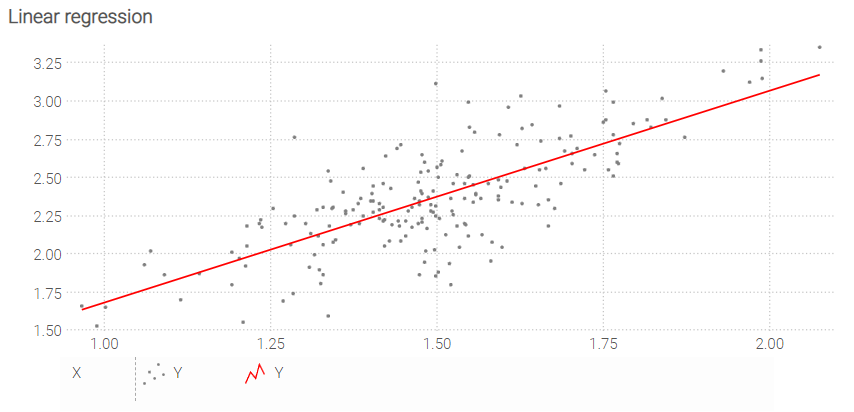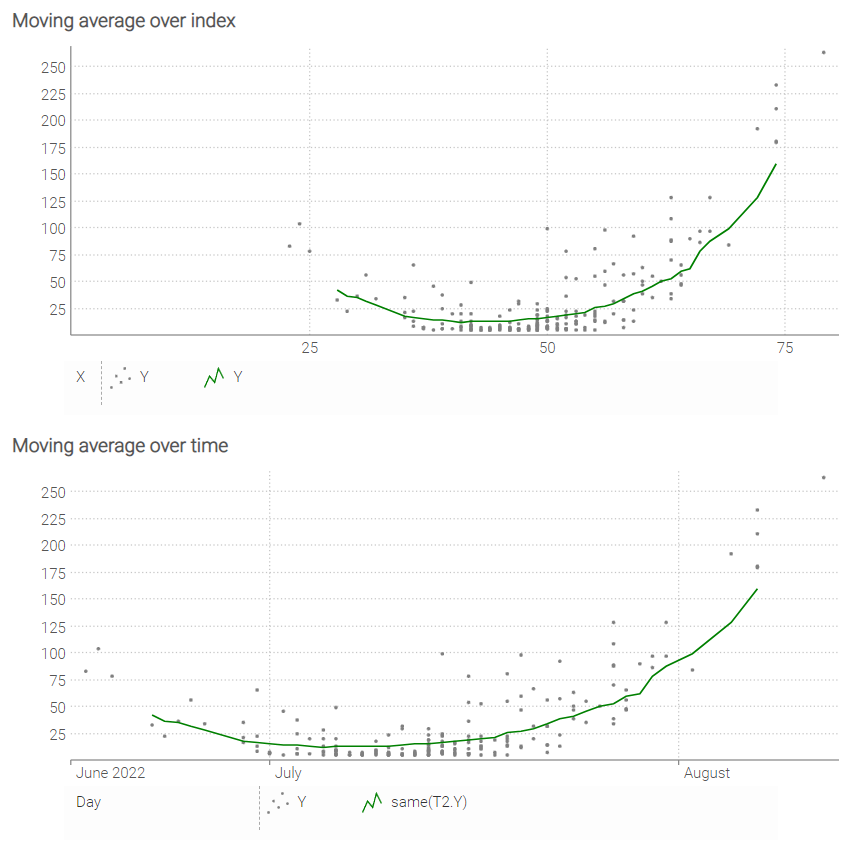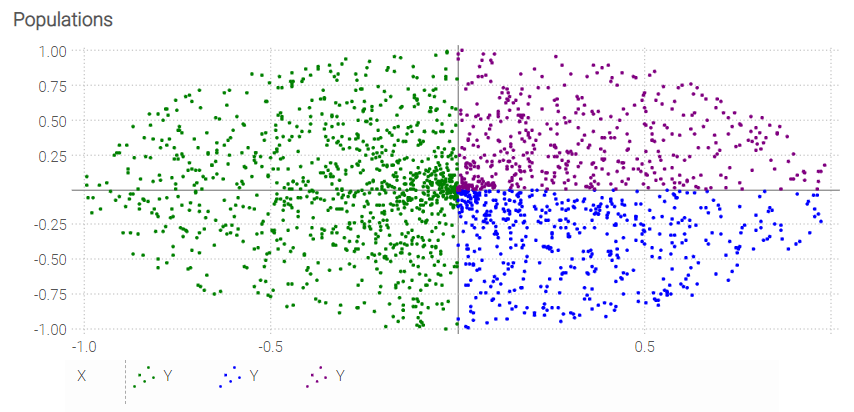chart
chart, tile type
The chart supports composing a series of internal tiles. Unlike the other tiles, the chart tile can take data from multiple tables as input.
Syntax
show chart introduces nested blocks that define the axes and series.
Blocks are indented under the with. Only plotxy blocks require an order by;
other blocks can end with order by when needed.
table T = extend.range(5)
T.X = T.N
T.Y = 2 * T.N
show chart "Scatter" with
scatter T.X
T.Y
Axis blocks
The horizontal axis can be free (no explicit haxis) or constrained.
Constrained axes support number, date, week, month, text, and enum.
table Sales = with
[| as Product, as Date, as Quantity |]
[| "socks", month(2024, 12), 10 |]
[| "socks", month(2024, 11), 3 |]
[| "hats", month(2024, 12), 4 |]
[| "hats", month(2024, 11), 11 |]
show chart "" with
haxis by Sales.Product
scatter Sales.Product
Sales.Quantity
To reuse an existing primary dimension, use haxis into:
table Sales = with
[| as Product, as Date, as Quantity |]
[| "socks", month(2024, 12), 10 |]
[| "socks", month(2024, 11), 3 |]
[| "hats", month(2024, 12), 4 |]
[| "hats", month(2024, 11), 11 |]
table Products = by Sales.Product
Products.Quantity = sum(Sales.Quantity)
show chart "" with
haxis into Products
order by Products.Quantity
plot into Products
Products.Quantity { seriesType: bar }
Vertical axes are always numeric. Use laxis and raxis blocks to attach StyleCode.
If both are present, series can specify vaxis: "left" or vaxis: "right".
Data blocks
The block types are:
scatter: point cloud, similar toshow scatter.plotxy: curve over explicit(X, Y)coordinates; requiresorder by.plot: curve over a constrainedhaxisusingplot byorplot into.
plot requires an haxis to be defined.
Illustration: linear regression

N = 200
table T = extend.range(N)
meanX = 1.5
sigmaX = 0.2
T.X = random.normal(meanX into T, sigmaX)
slope = 1.3
meanB = 0.4
sigmaB = 0.2
T.Y = slope * T.X + random.normal(meanB into T, sigmaB)
regressionA = (N * sum(T.X * T.Y) - sum(T.X) * sum(T.Y)) / (N * sum(T.X^2) - sum(T.X)^2)
regressionB = (sum(T.Y) - sum(T.X) * regressionA) / N
table LinReg = with
[| as X, as Y |]
[| min(T.X) into Scalar, (min(T.X) into Scalar) * regressionA + regressionB |]
[| max(T.X) into Scalar, (max(T.X) into Scalar) * regressionA + regressionB |]
show chart "Linear regression" { precision: 5 ; axisMin: min } with
scatter T.X
T.Y { color: gray }
plotxy LinReg.X
LinReg.Y { color: red }
order by LinReg.X
Illustration: moving average

N = 200
table T = extend.range(N)
meanX = 50
sigmaX = 10
T.X = round(random.normal(meanX into T, sigmaX))
slope = 0.4
meanB = -18
sigmaB = 2
T.Y = 5 + (slope * T.X + random.normal(meanB into T, sigmaB)) ^ 2
table T2[X] = by T.X
T2.Y = avg(T.Y) over X = [-8..8]
minX = min(T.X)
maxX = max(T.X)
show chart "Moving average over index" with
haxis by T2.X
scatter T.X
T.Y { color: gray }
where T2.X > minX + 4 and T2.X < maxX - 4
plot by T2.X
T2.Y { color: green }
T.Day = date(2022,05,25) + T.X
T2.Day = date(2022,05,25) + T2.X
show chart "Moving average over time" with
haxis by T2.Day
scatter T.Day
T.Y { color: gray }
where T2.X > minX + 4 and T2.X < maxX - 4
plot by T2.Day
same(T2.Y) { color: green }
Illustration: populations

N = 2000
table T = extend.range(N)
const PI = 3.14159274101
T.Theta = random.uniform(0,2 * PI into T)
T.R = random.uniform(0 into T, 1)
T.X = T.R * cos(T.Theta)
T.Y = T.R * sin(T.Theta)
show chart "Populations" with
where T.X < 0
scatter T.X
T.Y { color: green }
where T.X >= 0
where T.Y < 0
scatter T.X
T.Y { color: blue }
where T.Y >= 0
scatter T.X
T.Y { color: purple }
StyleCode
For generic StyleCode rules, see stylecode.
Scatter series support a radius StyleCode property (multiplicative) on their
value element, allowing bubble charts.
table T = with
[| as X, as Y, as Size |]
[| 0.2, 0.8, 3 |]
[| 0.4, 0.4, 6 |]
[| 0.7, 0.2, 10 |]
[| 0.9, 0.6, 8 |]
show chart "Bubble chart" with
scatter T.X
T.Y { radius: #[T.Size] }